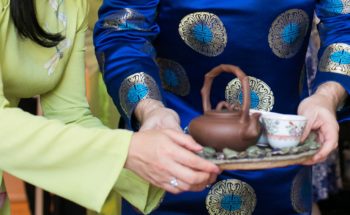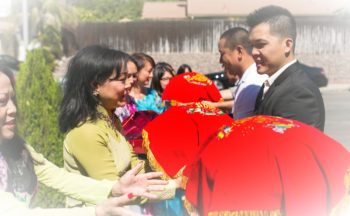Vietnamese Marriage Customs (1) – Lễ Dạm Hỏi Posted by Kandle Dart on Nov 30, 2021 in Culture, Events, Vocabulary
If you are thinking of getting married to a Vietnamese whose family follows tradition, prepare yourself both mentally and financially for the process! There are steps to follow with a series of events. It could be stressful and tiresome, perhaps even headache inducing, and a hassle. Nonetheless, the events are beautiful, joyous, and memorable when you will look back. No pain, no gain; right?
On an overseas trip back home to visit my parents, my husband had a heart-to-heart conversation with my late father regarding the Vietnamese traditional marriage customs, to which my husband experienced and went through in order to marry me. My dad laughed and commented: “With all seriousness, there is a reason for it. It’s something you’ll never want to endure again. Once in your lifetime is enough. Therefore, you better just stick with one marriage!”. In other words, better stick with your wife, because it’s a lot of trouble and effort to marry another one!
In the past, similar to Chinese traditions, the marriage customs were pretty complicated with many steps. In modern days, it has been streamlined and modified quite a lot for convenience. Basically, there still are five steps/events for the couple to go through, with three major ceremonies. These procedural customs are:
- Lễ dạm hỏi: It’s a meet and greet vísitation when permission for the boy to see/date the girl is asked).
- Lễ ăn hỏi/ Lễ đính hôn: It’s the engagement ceremony with betrothal gift
- Lễ cưới, include lễ xin dâu, lễ đón dâu, and lễ lại mặt: It’s the wedding ceremony, to include: collecting the bride (bride procession), receiving the bride, and after-wedding visitation to the bride’s parents ceremony.
Don’t freak out. It sounds like a lot but all the steps are natural and logical.
Since it’s too much information to squeeze into one blog, this will be the first of three blogs describing each of the three main ceremonies in order.
Lễ dạm hỏi or Lễ dạm ngỏ or Lễ chạm ngõ or Lễ xem mặt or Lễ vấn danh.
The name is called something slightly different, depending on the region. This is the initial step of the marriage. Basically, it’s the meet-and-greet between both familes. This gives the opportunity for the boy’s family to learn more about the girl’s family. This is a formal visit between the two families. It’s is also for the boy’s parents to ask the girl’s parents permission for their son to have contacts with the girl to lead to a marriage later.
The boy’s parents or a representative elder comes to the girl’s house, bringing traditional gifts to include:
- trầu (betel leaves)
- cau (area nuts)
- trà (tea)
- rượu (wine)
- hoa quả (fruits).
The girl’s family would then introduce their daughter to the boys’ family. She would serve tea to them and perhaps some sweet treats in a tray to the guests then withdraw from the conversation while the elders discussed the arrangement.
The Vietnamese still practice this custom today, however with some modification, depending on the situation and geographical area. This step is not important but still necessary to build a strong foundation for the couple to have a smooth engagement and wedding ceremony later.
Since people no longer chew trầu with cau, this given gift from the boy’s visit has faded out over time, replaced with sweet treats. Betel leaves were chewed with areca nuts to protect the teeth and gums by staining them, as well as considered necessary for beauty and health. Tea, wine, and fruit are still on the list, though optional.
In my case, I moved far away from home long ago for job opportunities. My husband and his family are westerners, who live over 10,000 miles away from my parents. Our parents on both sides speak different languages. To make it simple, my husband wrote a formal letter to introduce himself, his family members, and politely asked my parents for permission to plan for our engagement and marriage. The letter was in dual languages.
In my niece’s case, her fiancé’s parents are older and have some conditions which prevent them from traveling. And since they live a thousand miles away from her parents’ location, it was inconvenient for them to make a trip to visit the future in-laws house beforehand. They waited and had an informal lễ dạm hỏi then participated in their lễ đính hôn (engagement ceremony) a day after for convenience.
As you can tell, Vietnamese traditions emphasize the role of elders and family approval and participation along with the desires of the bride and groom. While this has changed significantly over the past few generations, many Vietnamese still involve parents and grandparents in many aspects of the engagement, wedding, and into the marriage. So, a Vietnamese marriage truly is a family affair!

Build vocabulary, practice pronunciation, and more with Transparent Language Online. Available anytime, anywhere, on any device.






